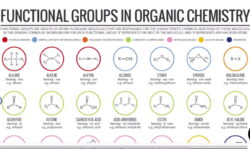
Content
• Empirical, molecular and structural formulae
• Functional groups and the naming of organic compounds
• Shapes of organic molecules; σ and π bonds
Candidates are expected to be able to interpret and use the following types of representations in the description of organic molecules. The examples given are for the compound (+)-lactic acid.
Empirical Formula: simplest ratio of the number of atoms of the elements present in one molecule, e.g. CH2O
Molecular Formula: actual number of the atoms of the elements present in one molecule, e.g. C3H6O3
Structural Formula: shows how the constituent atoms of a molecule are joined together with minimal detail, using conventional groups, for an unambiguous structure, e.g. CH3CH(OH)CO2H
Full Structural or Displayed Formula: detailed structure of molecule showing the relative placing of atoms and the number of bonds between them.
Skeletal Formula: simplified representation of an organic formula derived from the structural formula by removing hydrogen atoms (and their associated bonds) and carbon atoms from alkyl chains, leaving just the carbon-carbon bonds in the carbon skeleton and the associated functional groups.
Skeletal or partial skeletal representations may be used in question papers and are acceptable in candidates’ answers where they are unambiguous.
Stereochemical Formula: show spatial arrangement of bonds, atoms and groups in molecule in 3-D.
When drawing a pair of enantiomers, candidates should indicate the three-dimensional structures according to the convention used.
Candidates are expected to be able to interpret and use the curly arrow notation to represent the movement of electrons in organic reaction mechanisms.
Learning Outcomes
Candidates should be able to:
(a) interpret, and use the nomenclature, general formulae and displayed formulae of the following classes of compound:
(i) hydrocarbons (alkanes, alkenes and arenes)
(ii) halogen derivatives (halogenoalkanes and halogenoarenes)
(iii) hydroxyl compounds (alcohols and phenols)
(iv) carbonyl compounds (aldehydes and ketones)
(v)carboxylic acids and derivatives (acyl chlorides and esters)
(vi)nitrogen compounds (amines, amides, amino acids and nitriles)
(b)describe sp3 hybridisation, as in ethane molecule, sp2 hybridisation, as in ethene and benzene molecules, and sp hybridisation, as in ethyne molecule
(c)explain the shapes of, and bond angles in, the ethane, ethene, benzene, and ethyne molecules in relation to σ and π carbon-carbon bonds
(d)predict the shapes of, and bond angles in, molecules analogous to those specified in (c)
11.2 ISOMERISM
Content
•Isomerism: constitutional (structural); cis-trans; enantiomerism
Learning Outcomes
Candidates should be able to:
(a)describe constitutional (structural) isomerism
(b)describe cis-trans isomerism in alkenes, and explain its origin in terms of restricted rotation due to the presence of π bonds
[use of E, Z nomenclature is not required]
(c)explain what is meant by a chiral centre
(d)deduce whether a given molecule is chiral based on the presence or absence of chiral centres and/or a plane of symmetry
(e)recognise that an optically active sample rotates plane-polarised light and contains chiral molecules
(f)recognise that enantiomers have identical physical properties except in the direction in which they rotate plane-polarised light
[usage of the term diastereomers is not required]
(g)recognise that enantiomers have identical chemical properties except in their interactions with another chiral molecule
(h)recognise that different stereoisomers exhibit different biological properties, for example in drug action
(i)deduce the possible isomers for an organic molecule of known molecular formula
(j)identify chiral centres and/or cis-trans isomerism in a molecule of given structural formula
